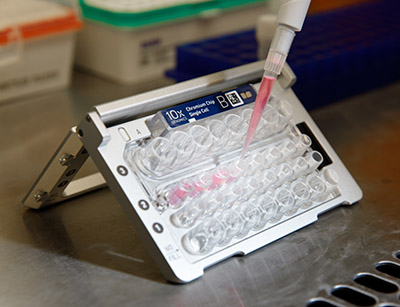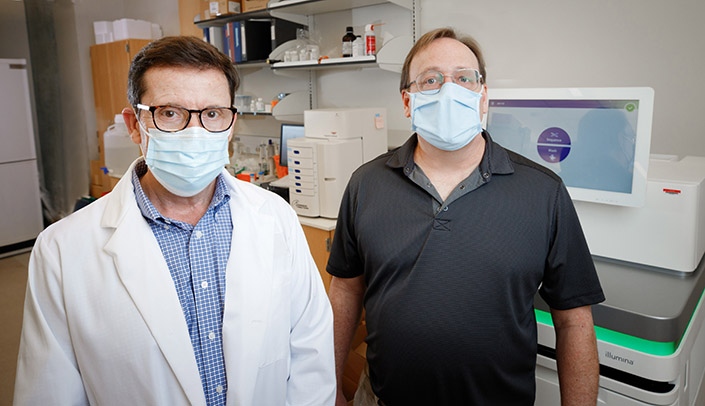James Eudy, PhD, director of the the UNMC Genomics Core Facility, calls single-cell genomics “another one of those hallmark changes in technology that’s completely changed what’s possible.”
“The ability to analyze RNA and DNA in individual cells is a major breakthrough,” Dr. Eudy said.
That capability is now available on the UNMC campus at the genomics and bioinformatics cores.
Meng Niu, PhD, bioinformatics data scientist in Babu Guda, PhD’s group at the Bioinformatics and Systems Biology Core Facility, which analyzes the data, said, “You can look at the tissues in a cellular level.”
And it’s already paying off in impactful discoveries documented by major papers.
 |
Gregory Kubik loads a micro fluidic chip that will be placed in the 10X Genomics Chromium Controller for processing. |
Tammy Kielian, PhD, Kommineni Professor of Pathology, said the new capability has been pivotal in her research.
“Prior to this work, we did not appreciate the diversity within individual immune cell populations, since this cannot be elucidated by other techniques, such as flow cytometry,” Dr. Kielian said. “We have utilized results from scRNA-seq performed in the Genomics Core in two recent manuscripts published in Nature Microbiology and The Journal of Immunology and are continuing to mine the data to design other mechanistic studies.”
Howard Fox, MD, PhD, senior associate dean for research in the College of Medicine, said, “My lab has similarly used scRNA-seq to obtain novel insights into the roles of infected as well as uninfected immune cells in the brain in an animal model for HIV, as published in a recent paper in Viruses.”
Previously, Dr. Eudy said, researchers had to look at perhaps a million cells at a time.
“The ability to look at individual cells allows you to see signals in cells we were not able to measure before because they’ve all been mixed together,” he said.
Now, Dr. Niu said, you are able to find what you are looking for. But, also, as others have pointed out, “the ability to explore more from their data” — to see what other information these cells might have to tell us.
Dr. Fox said his lab, working with the genomics and flow cytometry cores, has “validated a technique to use archived cryopreserved cells for scRNA-seq, now in press in iScience, that enables use of a wide variety of well-characterized sample without requiring the use of additional animals or human subjects.”
Staff from the genomics and bioinformatics cores — Dr. Eudy shouted out Greg Kubik, research technologist in the genomics core who operates the 10x Genomics single-cell capture instrument — work with investigators to develop protocols to get the most out of the technology.
“Greg has played a major role in getting the technology up and running,” Dr. Eudy said.

Way to go Greg and James!
Well deserved accolade.
Always great to see the value shared resources bring to research. Congrats to all!
Nice job Dr. Eudy!
Congratulations on getting this technology up and running. A game changer. Thank you Dr. Eudy and Greg Kubik.